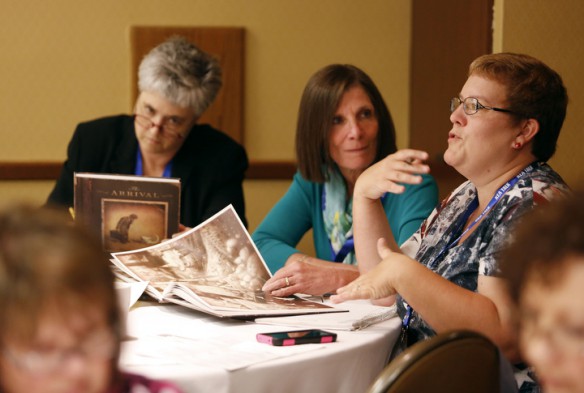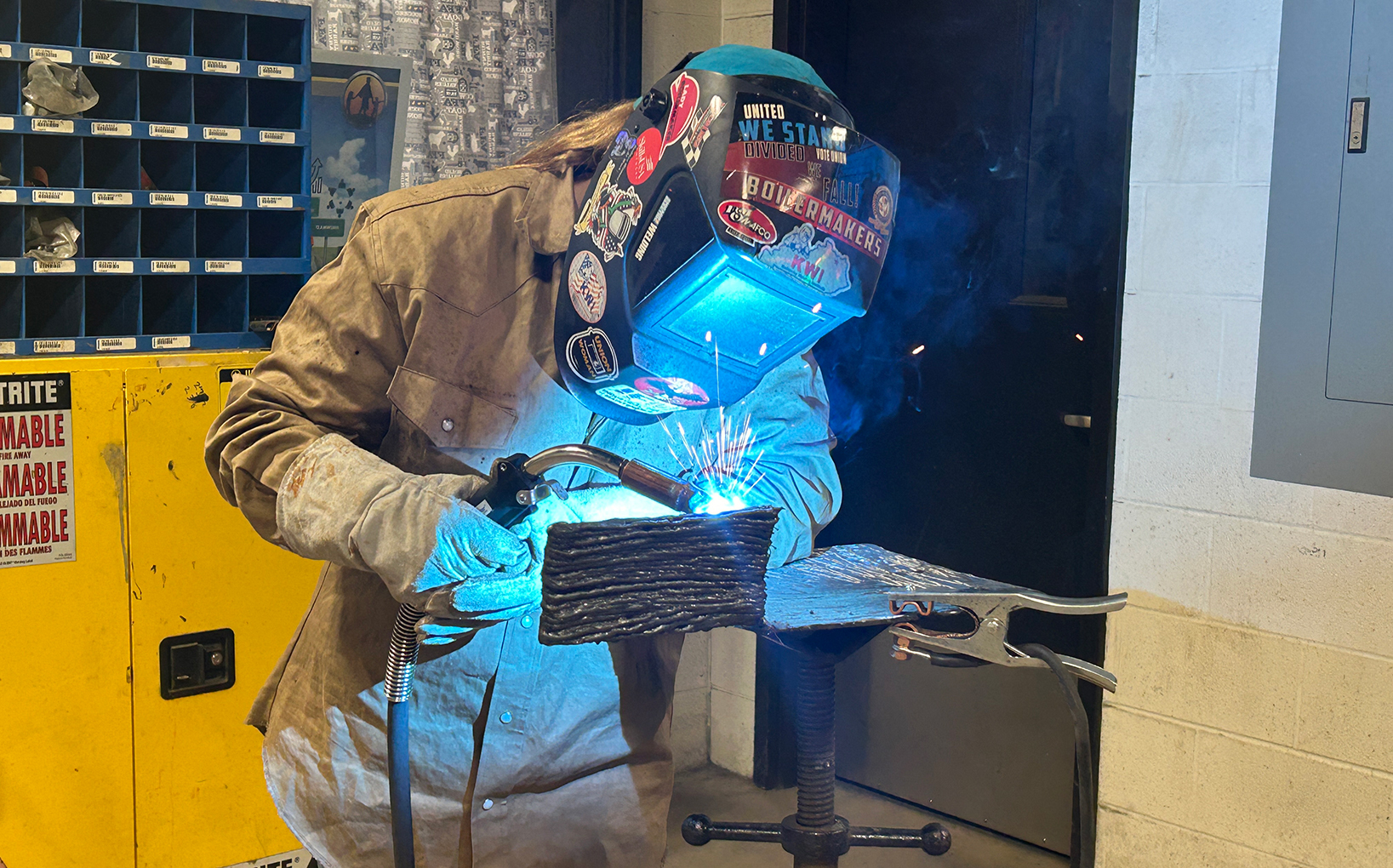
Amanda Bruce, Spencer County High School’s special education chair, talks about how graphic novels work well with her students during the Power of the Graphic Novel session at the Let’s TALK conference in Louisville.
Photo by Amy Wallot, June 16, 2014
By Brenna R. Kelly
Brenna.kelly@education.ky.gov
The first time Holly Wooten picked up a graphic novel, the Lafayette High School English teacher had no idea how to follow the cartoon panels inside, much less how to teach the book to her students.
“I had never even read a comic book before,” Wooten said. “When you first open it up you think, where do I start?”
But she quickly learned that the mash-up of images and text called graphic novels not because of explicit content, but because they are written and illustrated like comic books, could be a valuable tool to engage reluctant readers and teach students how to analyze literature and art.
At the second-annual Let’s TALK: Conversations about Effective Teaching and Learning conference in Louisville last week, Wooten and her fellow Lafayette (Fayette County)English teacher Christopher McCurry showed a room full of teachers not only how to use the medium, but how teaching the novels fits into the new Professional Growth and Effectiveness System.
“Graphic novels challenge readers of all abilities,” Wooten said. “It helps to engage those that don’t like to read, they don’t see it as reading. Also for students that have difficulty reading, it’s usually because they can’t visualize what they are reading. They don’t understand it, they can’t picture it, so this helps to provide them with that visual so they can follow the story.”
Most high school students are already familiar with graphic novels or at least the movies and television shows that they have spawned, McCurry said. Several comic book-based movies are listed on Internet Movie Database’s Top 250, including the Dark Knight, X-Men and the Avengers. The popular television series The Walking Dead is also based on a comic book series.
“These things are becoming more popular, they are becoming what students want to participate in so you can tap into that,” said McCurry, who also teaches a science fiction fantasy class in addition to AP literature.
And they aren’t just popular with high school students, said Jason Moncer, a library media specialist at Rosenwald-Dunbar Elementary (Jessamine County). This past school year, graphic novels accounted for 11.49 percent of the library’s circulation though they made up just 1.57 percent of the school’s collection, he said.
“It’s girls and boys, but primarily boys and boys that are reluctant readers,” he said. At elementary level there are graphic novels about dinosaurs, electricity and biographical graphic novels that that could be used in science or history lessons, he said.
Many of the graphic novels Wooten and McCurry brought for teachers to examine at the TALK conference breakout session could also be used outside of English class, the teachers said.
“The Arrival” by Shaun Tan, a story of a migrant told only with images would fit easily into a history class, they said.
When McCurry hands his students the wordless book in English class, they are a little confused, he said.
“It changes their understanding of what reading actually is,” he said. “A graphic novel like this one can really frame your entire working process. It’s basically like a big surprise.”
Teachers can use the novels for traditional literacy, such as analyzing transitions, character development, dialogue and structure but students can also analyze the pictures, how people are portrayed, how the author uses the panels to convey time, transition and motion.
While graphic novels might seem like light reading for an AP literature class, some have dense, complex texts that require a deeper reading, the teachers said.
Wooten and McCurry teach “Maus,” the 1991 graphic novel in which the author interviews his father about being a Holocaust survivor. The book was the first graphic novel to win the Pulitzer Prize.
“I felt nervous about teaching it,” said Wooten. “I didn’t think I was going to be able to understand it well enough to teach it when I looked at it for the first time.”
In the novel, the Jews are depicted as mice, the Germans as cats and non-Jewish Polish people as pigs. The novel would fit into social studies or English, McCurry said. Students can discuss why the author drew the characters as animals or they can compare and contrast other depictions of Jews – for example in a Nazi propaganda poster or in a poem, McCurry said.
“That’s why I love the graphic novel,” he said. “You get to this level of questioning with a poem or image and you get them thinking. Then it’s about a minute to transitioning into writing.”
McCurry recommended starting with “The Arrival,” then teaching “Persepolis,” which is about a young girl in Iran during the Islamic Revolution, then moving on to “Maus.”
Wooten and McCurry also explained how teaching the novels fit into the four domains of the Kentucky Framework for Teaching; planning and preparation, classroom environment, instruction and professional responsibilities.
For example, having students create their own graphic novels could improve the classroom environment because creating the books helps break down barriers between the students.
Wooten said a student who was a star football player drew himself as a football because that is how other students saw him.
“It breaks down stereotypes when students get to share with each other,” she said.
Amanda Bruce, special education department chairwoman at Spencer County High School, said she uses graphic novels with her non-verbal students and students with writing disabilities.
“Seeing how you can finally make a communication goal, that is huge,” she said.
Bruce was excited to see how the way she’s already teaching can tie into PGES.
“I can take this back to what we are doing with PGES and actually say, ‘Ok, here’s a lesson plan run with it,’” she said. “It makes it less of a scary proposition.”
Bruce, who has been teaching for six years, said she decided to start using the novels because her own children were reading them.
And that’s what is great about graphic novels Wooten and McCurry said, students become more engaged in the content and therefore will retain more. Wooten has seen students who didn’t enjoy reading have to be told to stop reading so the class can move on, she said.
“That is the biggest indication of growth right there,” she said, “if you can get them interested in reading something that shows growth in the student. If you can get them engaged, they will begin to retain and then a rise in test scores is just a natural symptom.”
MORE INFO …
Chis McCurry Christopher.mccurry@fayette.kyschools.us
Holly Wooten Holly.Wooten@fayette.kyschools.us






Thanks for this terrific article that tells the story of innovative, effective teaching and learning of the finest kind. Chris McCurry, the recipient of a fellowship to study at the Bread Loaf School of English, Middlebury College, is a leader in the national Bread Loaf Teacher Network and the Coordinator of the dynamic Kentucky Bread Loaf Teacher Network, where hundreds of students and teachers benefit from his work as a poet, teacher, and writer and his students’ accomplishments.